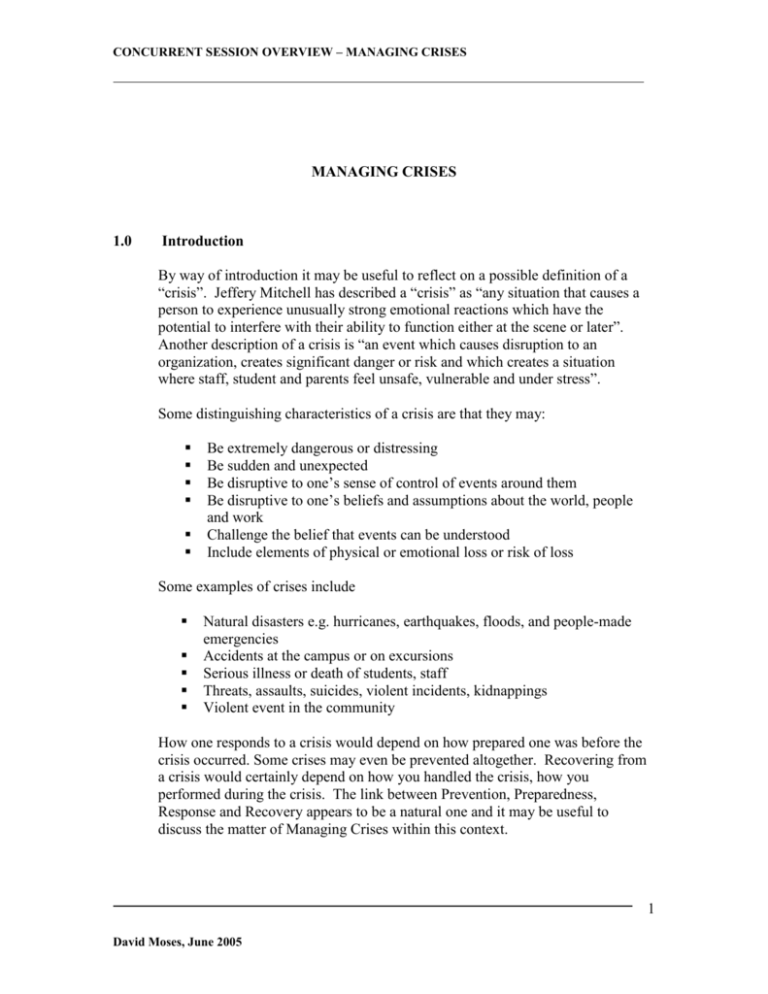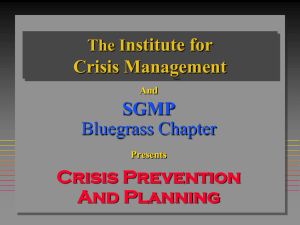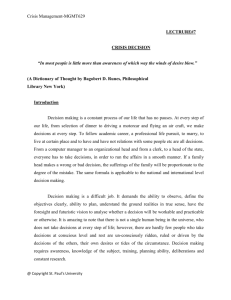Managing Crises
advertisement

CONCURRENT SESSION OVERVIEW – MANAGING CRISES MANAGING CRISES 1.0 Introduction By way of introduction it may be useful to reflect on a possible definition of a “crisis”. Jeffery Mitchell has described a “crisis” as “any situation that causes a person to experience unusually strong emotional reactions which have the potential to interfere with their ability to function either at the scene or later”. Another description of a crisis is “an event which causes disruption to an organization, creates significant danger or risk and which creates a situation where staff, student and parents feel unsafe, vulnerable and under stress”. Some distinguishing characteristics of a crisis are that they may: Be extremely dangerous or distressing Be sudden and unexpected Be disruptive to one’s sense of control of events around them Be disruptive to one’s beliefs and assumptions about the world, people and work Challenge the belief that events can be understood Include elements of physical or emotional loss or risk of loss Some examples of crises include Natural disasters e.g. hurricanes, earthquakes, floods, and people-made emergencies Accidents at the campus or on excursions Serious illness or death of students, staff Threats, assaults, suicides, violent incidents, kidnappings Violent event in the community How one responds to a crisis would depend on how prepared one was before the crisis occurred. Some crises may even be prevented altogether. Recovering from a crisis would certainly depend on how you handled the crisis, how you performed during the crisis. The link between Prevention, Preparedness, Response and Recovery appears to be a natural one and it may be useful to discuss the matter of Managing Crises within this context. 1 David Moses, June 2005 CONCURRENT SESSION OVERVIEW – MANAGING CRISES 2.0 Prevention Prevention relates to the identification of risks that can arise in the community of the academy and the development of policies and procedures which can contribute to reducing the risk of crises occurring and/or minimizing their effects. Risk Management is now regarded as an essential aspect of good management practice. Risk management involves the systematic identification of threats to resources and the development of strategies that minimize their adverse effects. An Occupational Health and Safety Policy supported by a Safety Committee is also now standard to most organizations, including academies, and would detail policies and procedures to safeguard against personal injury to members of that community. 3.0 Preparedness Preparedness is the planning and preparation of processes to be undertaken when a crisis occurs. This includes training and development and establishing links with relevant agencies and personnel. Most organizations would have a Disaster Preparedness Plan geared toward minimizing the adverse effects of a disaster. Pre-crisis planning can: Pre-empt or interrupt the development of a crisis Make a life-saving difference in an emergency Prepare staff strategically and psychologically for a crisis Minimize interruption to the learning environment Reduce risk of adverse publicity Minimize risk of reduced productivity, absenteeism, damaged community reputation Pre-crisis planning will: Undertake risk assessment Identify relevant services and establish liaison Develop a management plan and negotiate endorsement throughout the community of the academy Identify secure areas, mobile phone policy, siren policy, etc. Identify protocols to avoid escalating the risk Identify communication strategy during emergency and with staff, students families support services 2 David Moses, June 2005 CONCURRENT SESSION OVERVIEW – MANAGING CRISES A Pre-crisis Plan will include: 4.0 The formation of a crisis response team Identification of the range of emergencies covered in the plan Assessment of risks and hazards (potential and actual) Procedures to secure the safety of individuals and groups Procedures for evacuation Site maps, floor plans, identification of alternative assembly points Rehearsal of emergency practices Communication strategy: information to students, staff, families Identification of the recovery processes, including the review plan Response Response is the action undertaken to address the operational and psychological needs of the site community to stabilize the situation. It is the set of activities that are carried out immediately an emergency occurs and lasts until the risk to personal safety and /or property has been removed. While the community Emergency Services normally has the legal responsibility for coordinating and controlling the response of most types of emergencies the organization will normally maintain an ongoing responsibility for the safety and well being of students and staff for the duration of the emergency. At the onset of a crisis the physical safety and psychological protection of the community are the immediate priorities. One should: Take steps to end the danger and limit further physical and /or psychological injury. Follow site management plan on invacuation, evacuation, calling emergency services, screening areas off from view etc. Try to keep calm, issue clear instructions, and send for backup. Ensure that the principal or some other senior person will provide the leadership for the response and recovery It is always helpful to take a few moments to stop and think Appearing calm will help to give a sense of control Scan the site procedures to remind yourself what needs to be done Send for a member of the administration team Convene the crisis management team 3 David Moses, June 2005 CONCURRENT SESSION OVERVIEW – MANAGING CRISES As you assess the situation Ensure that the situation is stabilized Collect information from reliable sources and ensure that you are kept up to date Meet with crisis management team. Have crisis management plan in hand What support and emergency personnel are required? Is there a need for additional teaching support? Who is likely to be effected and how What needs to be communicated, to whom and by whom How will the situation be monitored What tasks need to be undertaken and by whom Possible personnel / agencies to consult include The police, Emergency Services Medical services Campus Principal Legal services Media Liaison Guidance Officer, Personnel Counsellor, Social worker Operational issues would involve Setting up a command centre or space, and communication strategy Allocating roles and responsibilities according to the crisis management plan Identifying particular tasks e.g. visiting family, attending to deceased person’s locker, etc. Identifying the process for parent and support personnel to visit the site Determining front office support to deal with extra calls Identifying gathering areas, parent meeting space, student/staff recovery as required Identifying the recording process to assist in keeping track of personnel/student needs, subsequent interventions, decisions made and action taken Timetable adjustment Relocation of work areas e.g. in the case of fire damage Considering how student/staff can be linked with significant others to reestablish a sense of personal control 4 David Moses, June 2005 CONCURRENT SESSION OVERVIEW – MANAGING CRISES At the end of the day one should ensure that The academy community members have information on the event and site response plan People have support contacts and/or helpful information on managing stress and emotional reactions The Emergency Management team has regrouped and debriefed the day, and modify the ongoing plan The recording process has been reviewed Since individuals react differently to a crisis thought should be given to the psychological well being of those involved in a crisis Consider the emotional well being of the community. Consider (with appropriate support from social worker, guidance officer, or personnel counsellor) the nature of the event, the potential impact and how to provide information and a supportive environment Ensure that information about personnel counsellor is routinely available since it is not possible to identify who will need additional support at the time or subsequently. Consider modifying each day’s programme; consider relief staff and supportive gestures (group events like morning tea). Staff may not want to be perceived as not coping and may force themselves to work. To assist recovery it may be more helpful in the long term to have temporary flexible working arrangements. Provide, wherever possible, an environment where staff and students can safely express their thoughts and feelings. Recovery rooms may be necessary. Ensure the monitoring of individuals/groups. ASI (Applied Strategies International), in an article published on the Internet has given some useful “Crisis Handling Principles” which I thought I should share with you, viz. Deal with all your audiences Remain flexible with regard to the unexpected Be conservative about reassurances Demonstrate concern Self praise is not as effective as external party endorsement Good news and bad news all have the same half life Tell the truth The press is after newsworthy events, do not create the news Building a defence by discrediting others has negative consequences 5 David Moses, June 2005 CONCURRENT SESSION OVERVIEW – MANAGING CRISES 5.0 The most underestimated audience is the silent majority Explanations of meeting mandatory requirements is not evidence of good management A single right answer does not exist Recovery The monitoring of recovery processes facilitates the return to routine. Recovery includes the review of policy and procedures. Recovery management is most effective when there is recognition of the complex, dynamic and sometimes protracted nature of recovery processes and the changing needs of affected individual and groups within the community. Leaders need to consider their own well being, and seek support and debriefing, as appropriate. The effectiveness of the recovery environment depends on: Factual information provided about the event and its effect The nature of reactions and availability of support The extent to which the site provides a supportive environment Whether the significance of the event is confirmed by others The extent to which specialist intervention and support is available Recovery would address restoring the academy’s community to a regular routine and this will be facilitated by Maintaining regular updated information to all staff. Staff will be better equipped to handle students if they are well informed and have opportunities to raise concerns and questions Some flexibility may be required as some staff and students may be unable to return to full/normal duties/routines. Monitor those situations Assist staff to create a safe, ordered environment as this will help to reassure students Maintain a supportive environment. Perception of supportive structures has the potential to act as a safety net and as an expression of concern for the well being of the community. In the unfortunate event that death had resulted from the crisis there would be the need to address the matter of the funeral. Leadership will need to consider staff attendance at the funeral. Student attendance is usually a family decision. 6 David Moses, June 2005 CONCURRENT SESSION OVERVIEW – MANAGING CRISES Rituals, ceremonies or memorials can be appropriate ways to honour the event/life of a person and are usually significant in comforting those distressed. The worksite may choose to have a memorial service, a plaque, the dedication of a book, trophy etc. or a contribution to the site’s grounds/garden. Finally there is the issue of promoting organisational learning. One should consider the need for an operational debrief. This needs to be done as part of the learning process and not to apportion blame. A range of issues may surface as a result of the crisis. These issues may relate to the need 6.0 To revise the Disaster Preparedness Plan To revise the curriculum to develop student understanding of grief and loss, developing resiliency, optimism and emotional intelligence Strengthening partnerships with families, departmental support services of agencies Staff professional development e.g. proactive responses to managing stress Conclusion Coping with a crisis need not be a hopeless battle. If we employ risk management techniques we may be able to identify some types of risk and put measures in place to minimise their negative effects. A range of possibilities exists for the managing of crises if we approach this responsibility from the perspective of Prevention, Preparedness, Response and Recovery. Acknowledgement Much of the material for this paper was taken from Internet published documentation by ASI (Applied Strategies International) on Managing Crises 7 David Moses, June 2005





